Arlington National Cemetery:
Lt. Col. Judge James F. Tierney
30 July 2009
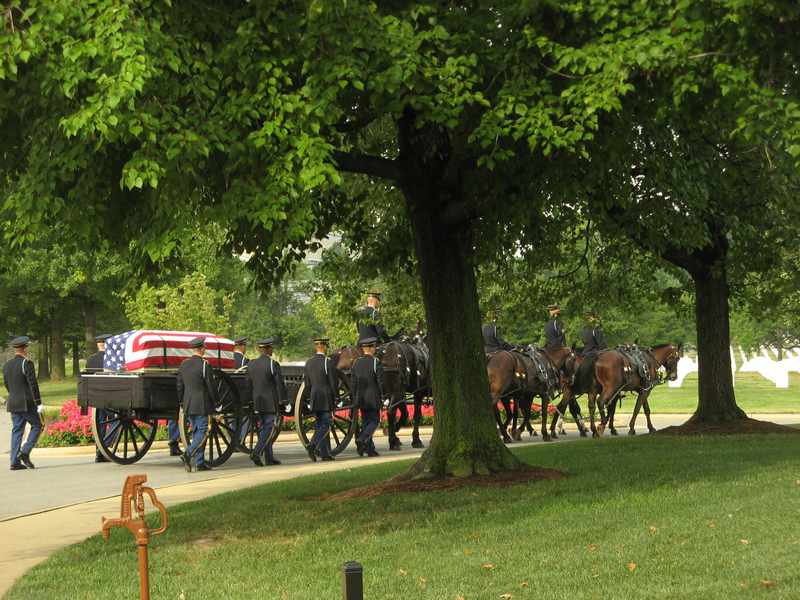
click to enlarge further; some browsers will go to Full Screen if you press F11
Eight pall bearers have loaded the caisson and walk beside it, pulled by seven horses and 3 riders.
The horses on the right are saddled, but have no rider.
This is not a "riderless horse," which would walk alone behind the caisson.
Instead, it harks back to the days of horse-drawn artillery pieces,
when the caisson carried the gun, and some horses were taken without riders,
in order to carry a greater weight of supplies.
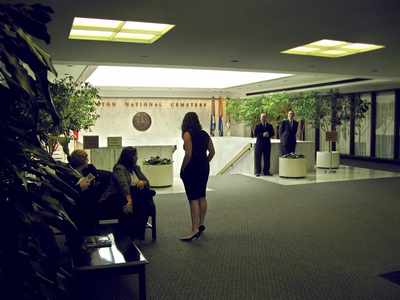
click to enlarge
The Arlington National Cemetery "Admin Building" serves as a funeral home with "family rooms." Mourners assemble, then drive in procession behind the hearse to a large shady cemetery location with room for a band and honor guard of riflemen, where pall bearers can transfer the coffin to a waiting caisson with its team of horses and drivers.
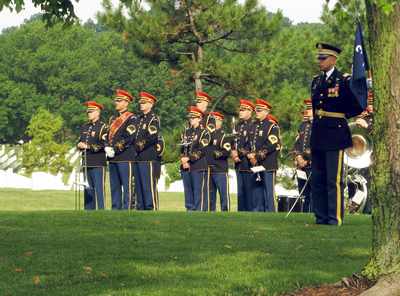
click to enlarge
Band plays before casket is loaded onto horse-drawn caisson.
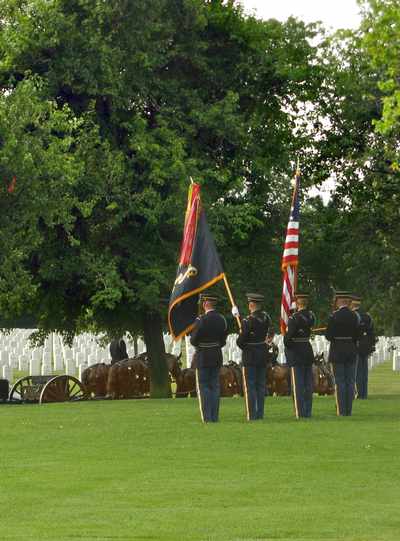
click to enlarge
Honor Guard stands at attention while casket is loaded onto horse-drawn caisson.
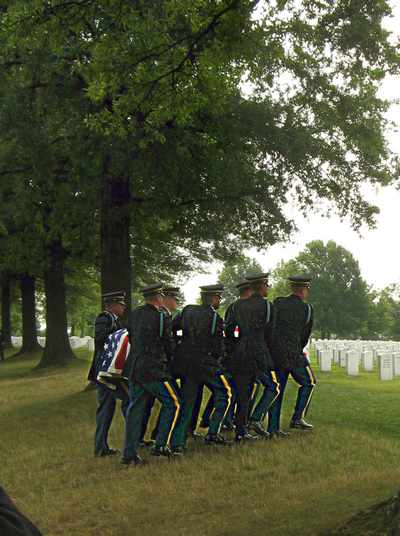
click to enlarge
The end of the caisson's journey -- eight pall bearers carry the coffin to its grave.
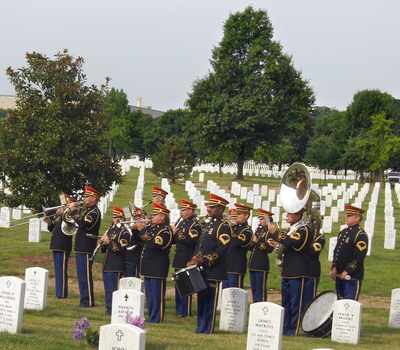
click to enlarge
Band and Honor Guard march with us behind the pall bearers to the graveside. Following music at graveside, there is a brief service. The service ends with a slow, solo bugle playing taps.
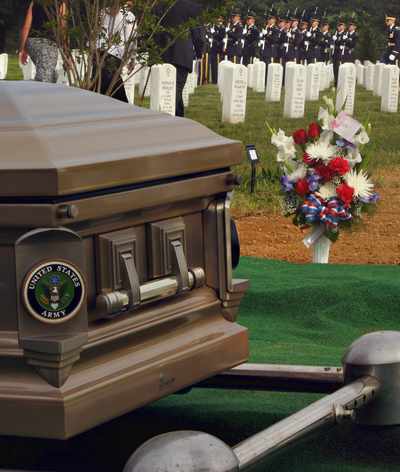
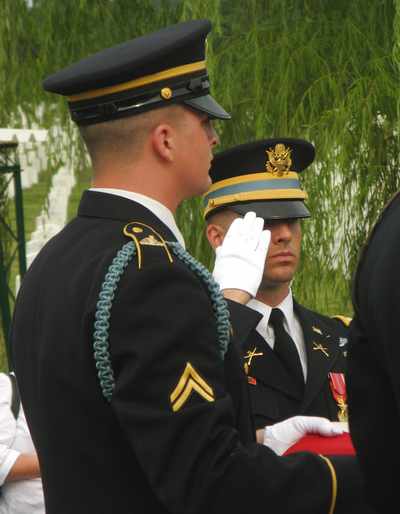
click to enlarge
The coffin was not lowered into its grave as part of the ceremony. (right) Acting quickly in response to the leader's smart snap of the flag, the pall bearers fold the coffin-draping flag in half the long way twice, then fold it up in repeated triangles. The alas familiar triangularly-folded flag to which each United States veteran is entitled is then passed to the widow. The folding job, done wearing white gloves, was perfect.
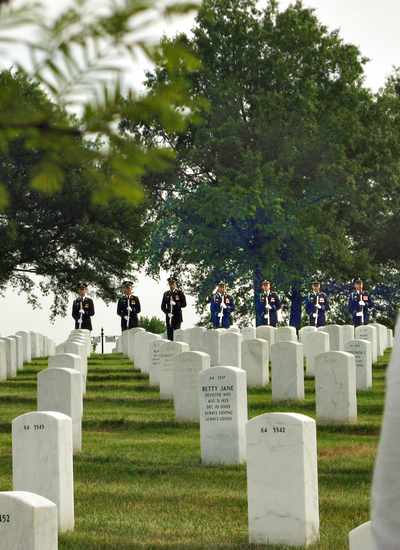
click to enlarge
At their leader's command, seven (or eight?) riflemen from the 18-rifleman honor guard fire their weapons three times. The silence into which taps descended is shattered. The burial is over.
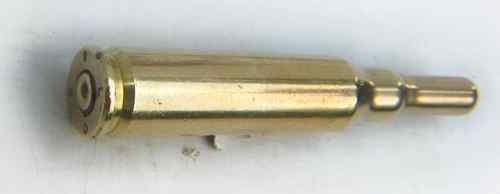
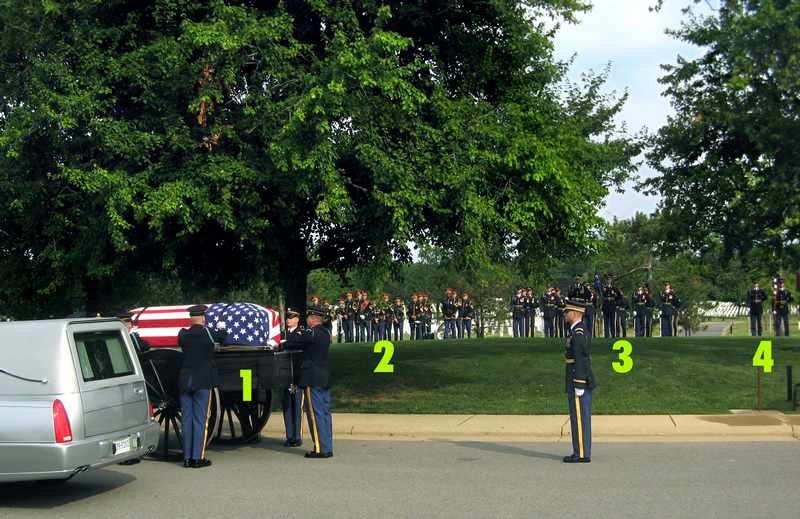
Burial at the rank of Lt. Col.
Guests
assemble in a designated family room at the Arlington National Cemetery
Administration Building, then return to their cars to follow the hearse
to its rendezvous with a horse-drawn caisson at a designated "transfer
point" within the Cemetery.
1. Eight pall bearers transfer coffin from hearse to caisson drawn by 7 horses and 3 riders.
A symbolic "riderless horse" is one that walks alone behind the caisson. We did not have this.
Such a "caparisoned horse" is used for full colonels and above.
2. A full band plays at the loading of the caisson and then follows it to the grave site and plays again.
3. Eighteen riflemen move with the band from transfer point to grave site.
4. A three-man honor guard carry the infantry unit's colors.
After the graveside service, a member of the band plays taps, and 7 (or 8?) members of the riflemen, at command of their leader, fire 7 rounds simultaneously three times in a row. A rifle is not a "gun", and these three volleys are not a 21 "gun" salute, which is used more to greet dignitaries or mark important days at noon or dusk than to embellish funerals. The shells were blanks without bullets. The flag detail (in our case, the 8 pall bearers) often slips three shell-casings into the folded flag before presenting the flag to the family. Each casing represents one volley. The Tierney family received some of the shells, but I do not know if it was through this traditional route to Jim's children that we came to have one to keep always and pass on to our son.
--jerry
J. I. Nelson, Ph.D.
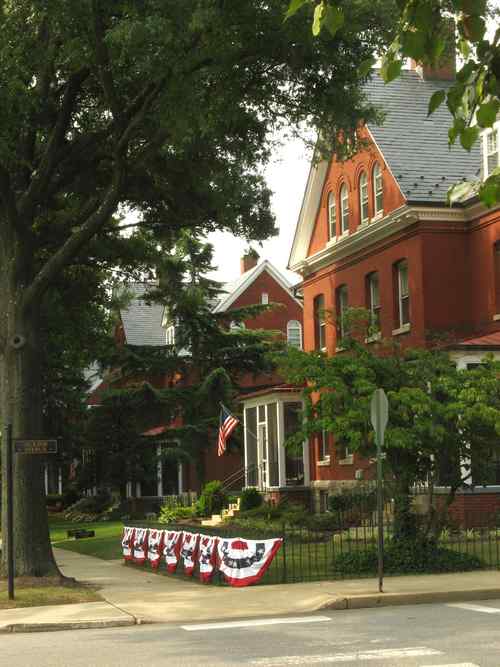
click to enlarge
Officer's quarters like this Victorian home and about 25 others were built between about 1890 and the 1930s.
Today, it takes a rank of Brigadier General or higher to get a house on "General's Row".
Our reception was held in the Officer's Club at the head of General's Row.
top of this burial page
rev 3Aug09, 17Aug
1. Eight pall bearers transfer coffin from hearse to caisson drawn by 7 horses and 3 riders.
A symbolic "riderless horse" is one that walks alone behind the caisson. We did not have this.
Such a "caparisoned horse" is used for full colonels and above.
2. A full band plays at the loading of the caisson and then follows it to the grave site and plays again.
3. Eighteen riflemen move with the band from transfer point to grave site.
4. A three-man honor guard carry the infantry unit's colors.
After the graveside service, a member of the band plays taps, and 7 (or 8?) members of the riflemen, at command of their leader, fire 7 rounds simultaneously three times in a row. A rifle is not a "gun", and these three volleys are not a 21 "gun" salute, which is used more to greet dignitaries or mark important days at noon or dusk than to embellish funerals. The shells were blanks without bullets. The flag detail (in our case, the 8 pall bearers) often slips three shell-casings into the folded flag before presenting the flag to the family. Each casing represents one volley. The Tierney family received some of the shells, but I do not know if it was through this traditional route to Jim's children that we came to have one to keep always and pass on to our son.
--jerry
J. I. Nelson, Ph.D.

click to enlarge
Officer's quarters like this Victorian home and about 25 others were built between about 1890 and the 1930s.
Today, it takes a rank of Brigadier General or higher to get a house on "General's Row".
Our reception was held in the Officer's Club at the head of General's Row.
top of this burial page
obituary
BIO for Jim Tierney, emphasizing his early life
background on the IG Farben industrial cartel, which Jim help prosecute at the Nuremberg War Crimes trials
Some Tierney family photos
home for this Web site,
such as it isBIO for Jim Tierney, emphasizing his early life
background on the IG Farben industrial cartel, which Jim help prosecute at the Nuremberg War Crimes trials
Some Tierney family photos
rev 3Aug09, 17Aug